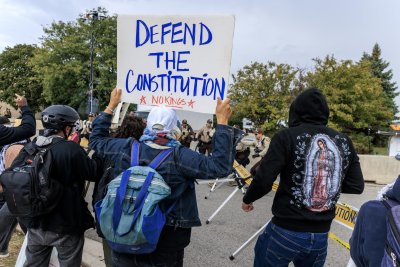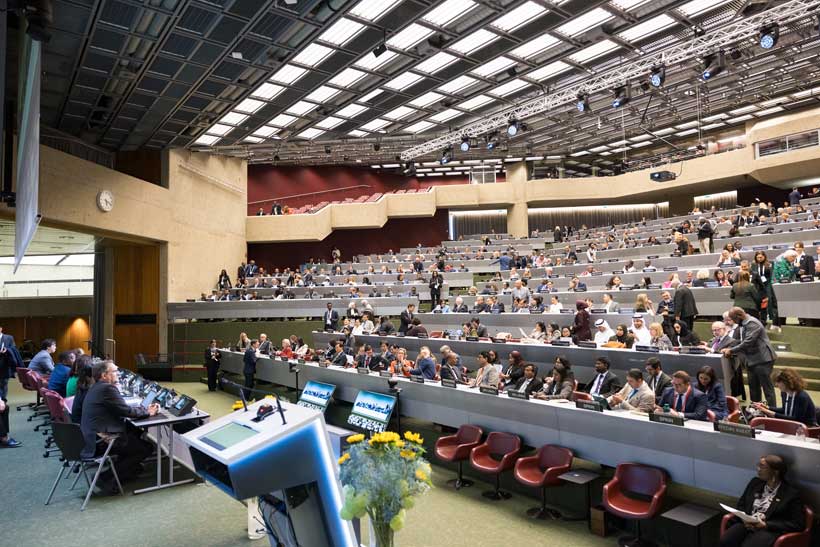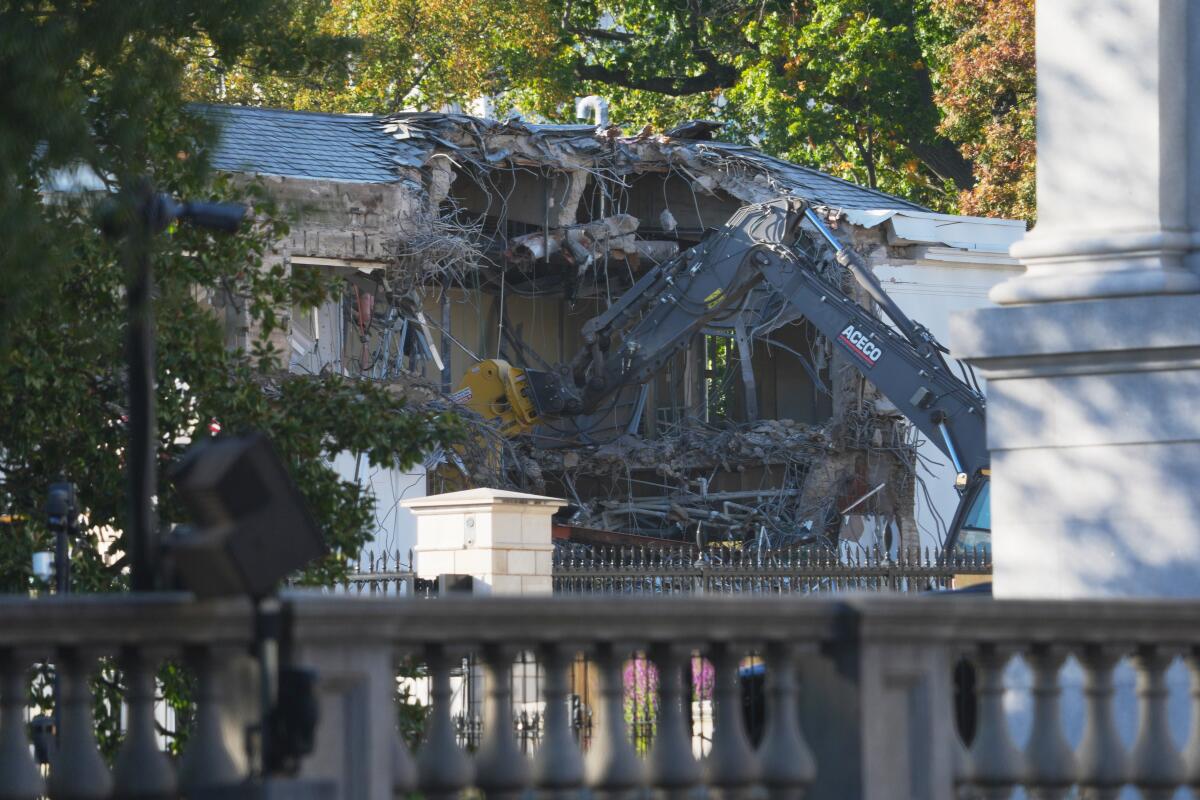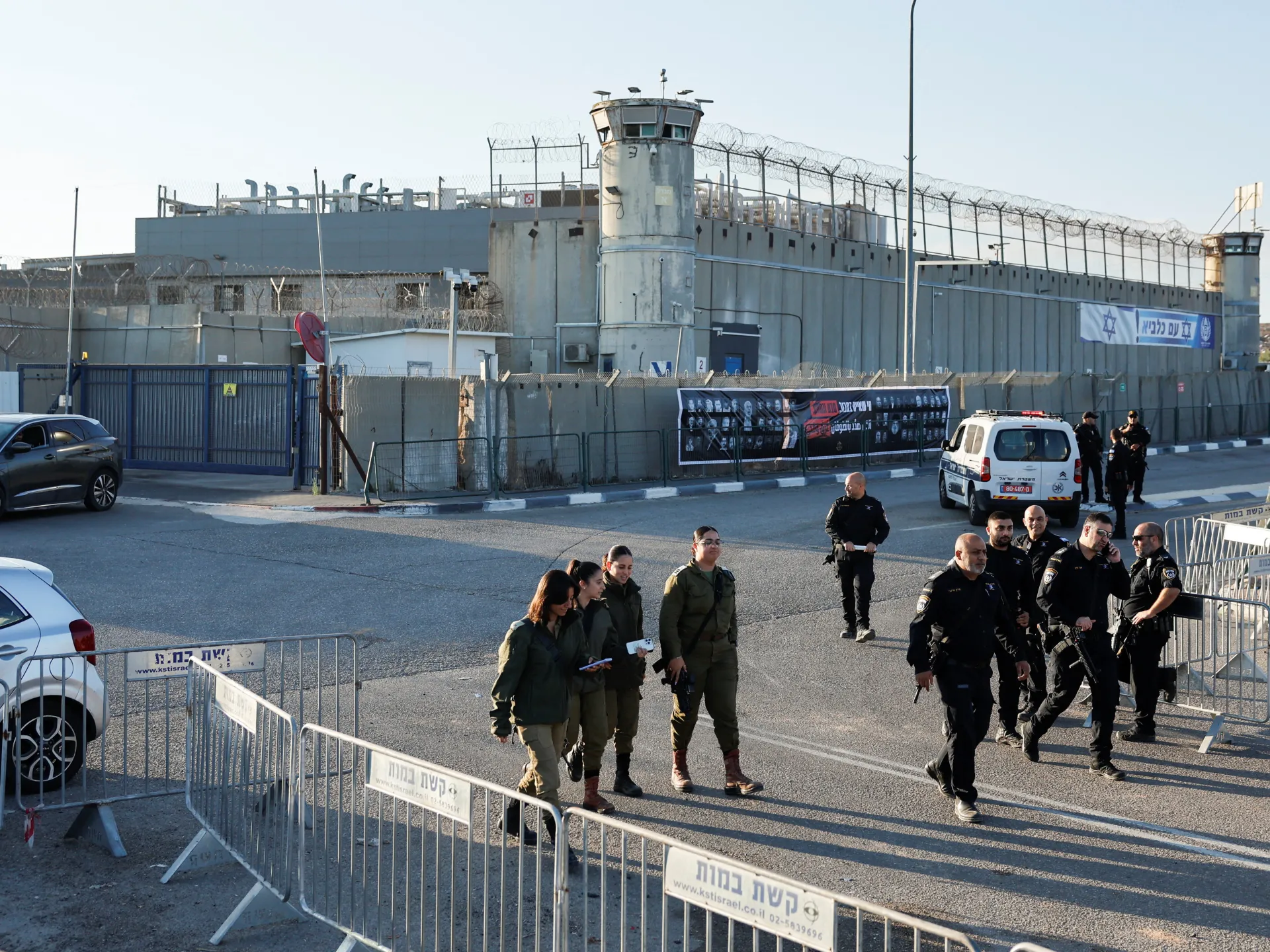Judge keeps block of National Guard in Chicago before high court decision

Activists participate in a demonstration outside the ICE detention facility in Broadview, Ill., on Oct. 10. A federal district judge is blocking the National Guard from deploying in the city. Photo by Christobal Herrera Ulashkevich/EPA
Oct. 22 (UPI) — A federal judge on Wednesday extended her order blocking the deployment of National Guard troops to Chicago before the U.S. Supreme Court weighs in.
District Judge April Perry, who was appointed by President Joe Biden, decided to keep the ban until there’s a full trial on the issue or the high court rules.
On Oct. 9, Perry issued the original order that was to expire Thursday.
Five days earlier, Trump ordered the deployment to Chicago.
Her earlier decision came as 200 members of the Texas National Guard arrived at the Immigration and Customs Enforcement facility in the south Chicago suburb of Broadway. People opposed to the ICE presence have protested there.
The deployment also included 300 members of the Illinois National Guard and 16 troops from California.
Perry had found there was “no credible evidence that there is a danger of rebellion in the state of Illinois.” She said the Department of Homeland Security’s information of protests are “unreliable.”
On Thursday, the three-judge 7th Circuit Court of Appeals backed Perry’s ruling, writing that “political opposition is not rebellion.”
The Trump administration accused the appeals judges of “judicially micromanaging the exercise of the President’s Commander-in-Chief powers.”
The federal government filed an emergency appeal to the high court.
Originally, Department of Justice lawyers proposed extending that order another 30 days in a Tuesday filing.
But because a temporary restraining order can only be extended once, the judge warned Wednesday that “whatever extension we make has to be the right one” to prevent a gap in judicial orders “that would allow troops be deployed on the streets.”
In a filing Friday to the Supreme Court, U.S. Solicitor General John Sauer said the judicial branch has no right to “second guess” a president’s judgment on national security or military actions. He said the guard is needed to protect federal immigration agents and property from protesters.
Even if the high court stays Perry’s temporary restraining order, the state would seek a “quick trial” or other expedited injunction hearing, Illinois Attorney General Kwame Raoul’s office said.
In Portland, Ore., an expedited trial is planned for next week after the 9th Circuit Court of Appeals on Monday overturned another temporary restraining order by U.S. District Judge Karin Immergut, a Trump appointee, blocking National Guard deployment there.
On Wednesday night, the Trump administration asked the full circuit not to examine the three-judge ruling.
The district judge in Oregon is planning a hearing on Friday to consider whether to dissolve or suspend the temporary restraining order.
The Trump administration is planning to send dozens of federal agents to San Francisco on Thursday, a source told CNN.
We must renew our commitment to humanitarian action and norms
This week, legislators from over 120 national parliaments are meeting in Geneva to assess the world’s collective response to humanitarian crises.
Unprecedented rates of armed violence and forced displacement, together with climate change, public health emergencies, and food insecurity, have combined with the disintegration of our systems for international solidarity.
This has created a toxic cocktail that is causing untold suffering and costing lives.
The numbers are staggering. More than 122 million people are forcibly displaced, and almost 310 million people need humanitarian assistance.
As is so often the case, the vulnerable are the most brutally affected. One in every five children in the world—approximately 400 million—are living in or fleeing conflict zones.
Children caught up in crises often face the double jeopardy of losing their homes and their education.
Before entering parliament, I was a teacher, drawn to the profession because I knew how crucial education is to children.
But education is often the first casualty during crises and too frequently neglected by an overstretched and underfunded humanitarian system.
As a result, 234 million crisis-affected children and adolescents need urgent educational support, and over 85 million are out of school.
Depriving children in these contexts of an education robs them not just of the opportunity to learn the vital skills they need for life but also to a platform to receive life-saving services like food, water, and basic health care.
Thankfully, in many crisis situations where governments lack the resources to provide education, local and international non-government organisations step in and help ensure that children get the chance to go to school.
However, the drastic cuts to development and humanitarian assistance that many countries have made this year are putting this vital work at risk.
Projections indicate that total official development assistance for education may decline by USD3.2 billion by 2026, representing a nearly 25 percent decrease from 2023 – which could potentially displace another six million children from school in the coming months.
Earlier this year, humanitarian appeals were slashed by up to 90 percent in Sudan and Chad, leaving 33 million adults and children in need of life-saving assistance, without any support.
Despite a record number of refugees, the UN refugee agency, UNHCR, has received only a quarter of the funding that it needs in 2025, forcing it to halt or suspend about $1.4 billion in programs and to slash more than one-third of its education budget.
In the refugee camps that host Rohingya refugees in Bangladesh, up to half a million boys and girls are now left without any form of schooling.
Ninety per cent of the world’s refugees live in low- and middle-income countries whose education systems already struggle to ensure every child is in school and learning.
In such cases, it is evident that host countries need support from the international community to provide the refugees they are hosting with access to education.
Education is also what crisis-affected communities want. Displaced parents and children consistently identify access to quality education as one of their highest-priority concerns.
Despite the enduring hardships they face, the determination of displaced communities to provide their children with an education is inspiring. They deserve our support.
That is why I am proud that Denmark, where I am a member of the national parliament, has affirmed its commitment to provide aid funding at or above the UN target of 0.7% of its gross national income (GNI).
With crises and conflicts multiplying around the world, it is more necessary than ever to strengthen international solidarity, and I hope that Denmark can inspire others to renew their commitment to solidarity through development cooperation and humanitarian assistance.
Tragically, a lack of funding is not the only threat to humanitarian response. The most fundamental humanitarian norms are being challenged in today’s war zones.
Current conflicts show, in appalling and devastating ways, the significant challenges facing international humanitarian law in providing effective and meaningful protection for people affected by armed conflicts.
Once again, education proves the point.
In 2022 and 2023 – the latest years for which comprehensive data is available – there were around 6,000 reported attacks on education and incidents of military use of schools and universities, harming more than 10,000 students and educators globally.
This represents a 20% increase on the previous two years, and the fear is that the number and severity of attacks on education personnel, facilities, and schools has continued to grow.
But there is a different way.
In 2015, Argentina and Norway launched the Safe Schools Declaration with the objective of avoiding military use of schools and strengthening the protection of children and education in conflict. It has since been adopted by 121 states.
Meanwhile, just last year, the International Committee of the Red Cross launched a global initiative to galvanize political commitment to international humanitarian law (IHL). Some 89 states have signed up to support the initiative.
International cooperation, like these initiatives, to address global challenges, has never been more critical.
As the institutions that represent the people, parliaments are uniquely positioned to mobilize political will, champion inclusive governance and dialogue, challenge narratives, and be the voice of the most vulnerable.
Parliaments are also key actors in translating global humanitarian norms into domestic legislation and policy, scrutinizing government action over humanitarian commitments, and allocating resources to tackle pressing humanitarian challenges.
Right now, parliamentary diplomacy – MPs from different parliaments talking and working together – has the opportunity to play a pivotal role in reinforcing multilateral values such as inclusion, solidarity, cooperation, shared responsibility, and the rules-based international order.
This week’s meeting of national parliaments in Geneva won’t solve the multiple crises we face, but it might just begin the process of reminding us that the challenges we face are global in nature and need global solutions, and forging new people-to-people relationships to do precisely that.
Celebrity Traitors star Celia Imrie makes cheeky confession about rival contestant
Celia Imrie, who was in Thursday Murder Club, shared suspicions Jonathan Ross could be a villain in the BBC’s Celebrity Traitors, during which Welsh singer Charlotte Church was “murdered” yesterday

Veteran actress Celia Imrie told Jonathan Ross she has “a bit of a crush” on him during last night’s Celebrity Traitors.
The performer, who was in Thursday Murder Club this year, made the admission as she considered Ross, 64, could be a traitor. Imrie, 73, voted to boot him out following the roundtable discussion on Wednesday’s drama-packed episode.
Imrie, who has been in popular dramas and films for the past five decades, said: “This is a bit tricky because I’ve got a bit of a crush on you right now, but I put you Jonathan because I think you have the chutzpah and brilliance to be a traitor.”
After two rounds of voting that ended with Scottish actor Mark Bonnar and historian David Olusoga receiving an equal amount of votes, presenter Claudia Winkleman announced the banishment would be left to chance.
READ MORE: The Celebrity Traitors stars were stopped from sneaking between bedrooms at hotelREAD MORE: Real-life Celebrity Traitors castle is available to book – but there’s a catch
The episode ended before the result of the banishment, which takes place following a roundtable discussion that sees contestants debate the identity of the secret traitors who meet at night to plot their next “murder”, in a bid to take the charity prize pot from the faithfuls.
A number of scenes with Imrie have gone viral, including when she audibly passed wind during a stressful mission in a cabin, prompting gales of laughter from her fellow cast members, as well as viewers around the country.
Another clip of Imrie, which showed her howling down a well while mimicking the sound of a banshee for a challenge, was turned into a meme.
READ MORE: The Celebrity Traitors star Ruth Codd shares tragic reason behind leg amputation
She prompted further laughs when, before the challenge, comedian Lucy Beaumont said “you know what you do in a well, don’t you?”, to which she replied: “Put the pussy in.”
Until Imrie’s confession, none of the Traitors – Ross, Alan Carr, and Cat Burns – had really even been suspected – but is their time running out and are the Faithfuls finally onto them?
Earlier in the episode, Welsh singer Charlotte Church became the latest contestant to be “murdered” by the traitors – comedian Alan Carr, TV presenter Jonathan Ross and singer Cat Burns – who had plotted their next move during last Thursday’s episode.
Reacting to her murder, Church, 39, said: “I thought I was going to be murdered. I’m outspoken at the round table, and I’m outspoken with my opinions, not that I was successful in being much of a threat to the traitors. But as the game progressed, I hope that I would’ve been. I hope that that’s why they’ve gotten rid of me. Well played traitors.”
Vendors on NYC’s Canal Street say they were harassed and asked to show papers in immigration sweep
NEW YORK — A day after a mass of federal agents questioned street vendors and sparked protests on Manhattan’s Canal Street, sellers were scarce on the busy strip. Some who did venture out Wednesday, though, were disheartened or riled up by a sweep in which they said people, including U.S. citizens, were pressed to show their papers.
Federal authorities said 14 people, including immigrants and demonstrators, were arrested in Tuesday’s sweep. The Department of Homeland Security said it was a targeted operation focused on the alleged sale of counterfeit goods, and Immigration and Customs Enforcement acting Director Todd Lyons said it was “definitely intelligence-driven.”
“It’s not random. We’re just not pulling people off the street,” he told Fox News on Wednesday.
But some vendors saw it as an indiscriminate and heavy-handed crackdown by masked agents who queried a wide swath of sellers.
Awa Ngam was selling sweaters Wednesday from a table at a Canal Street intersection where at least one of her fellow vendors was taken away the previous afternoon.
She said she also was asked for ID, showed it, and then for her passport, which she doesn’t carry around. Agents quizzed her about how she had come to the U.S., but they eventually backed off after her husband explained that she’s an American citizen, she said.
“They asked every African that was here for their status,” Ngam said.
She returned to the spot Wednesday unafraid but upset.
“I’m saddened because they should not walk around and ask people for their passport in America,” said Ngam, who said she came to the U.S. from Mauritania in 2009. She added that if not for her legal immigration status, she would be fearful: “What if they took me? What would happen to my kids?”
Some other sellers decried the sweep as harassment. Others were keeping a low profile and shied from speaking with journalists.
Signs freshly posted on streetlights mentioned Tuesday’s sweep and urged people at risk of detention to call an immigration law group’s helpline.
Separately, state Atty. Gen. Letitia James, a Democrat, asked New Yorkers to send in photos or videos of Tuesday’s immigration sweep so that her office could assess whether laws were broken.
Law enforcement raids aimed at combating counterfeiting are relatively frequent on Canal Street, which is known for its stalls and shops where some vendors hawk knockoff designer goods and bootlegged wares. Federal authorities often team up with the New York Police Department and luxury brands on crackdowns aimed at shutting down illicit trade.
But the sight of dozens of masked ICE and other federal agents making arrests drew instant protests.
Bystanders and activists converged at the scene and shouted at the agents, at one point blocking their vehicle. ICE, Border Patrol and other federal agents tried to clear the streets, sometimes shoving protesters to the ground and threatening them with stun guns or pepper spray before detaining them.
Nine people were arrested in the initial immigration sweep, DHS spokesperson Tricia McLaughlin said. Four more people were arrested on charges of assaulting federal law enforcement officers, she said, adding that a fifth was arrested and accused of obstructing law enforcement by blocking a driveway.
McLaughlin said some of the people arrested had previously been accused of crimes, including robbery, domestic violence, assaulting law enforcement, counterfeiting and drug offenses.
The sweep came after at least two conservative influencers shared video on X of men selling bags on Canal Street’s sidewalks.
While clashes between immigration authorities and protesters have played out in Los Angeles and other cities, such scenes have been rarer on New York City streets, which Mayor Eric Adams has attributed in part to his working relationship with President Trump’s administration.
Adams, a Democrat, said city police had no involvement in Tuesday’s immigration sweep.
“Our administration has been clear that undocumented New Yorkers trying to pursue their American dreams should not be the target of law enforcement, and resources should instead be focused on violent criminals,” he said.
Peltz and Offenhartz write for the Associated Press.
Prep talk: South Gate QBMichael Gonzalez is making an impact
If you want to see a player whose impact is growing, go watch South Gate junior quarterback Michael Gonzalez. He’s listed as 5 feet 9 on the Rams’ roster, but what an arm he has and he can run, too.
He passed for 273 yards last week in a loss to Garfield. He has passed for 1,999 yards and 22 touchdowns in eight games. He’s also scored six touchdowns.
Receiver Nicholas Fonseca, another junior, has 52 receptions for 1,027 yards and 10 touchdowns. He was the City Section Division II player of the year last season.
South Gate is 5-3, with the duo leading the way. The Rams’ passing attack could set them apart for the Division I playoffs.
This is a daily look at the positive happenings in high school sports. To submit any news, please email [email protected].
Conservative activist sues Google over AI-generated statements | Technology News
The lawsuit comes amid growing concerns about how AI fuels the spread of misinformation.
Published On 22 Oct 202522 Oct 2025
Share
Conservative activist Robby Starbuck sued Google, alleging that the tech giant’s artificial intelligence systems generated “outrageously false” information about him.
On Wednesday, Starbuck said in the lawsuit, filed in Delaware state court, that Google’s AI systems falsely called him a “child rapist,” “serial sexual abuser” and “shooter” in response to user queries and delivered defamatory statements to millions of users.
Recommended Stories
list of 4 itemsend of list
Google spokesperson Jose Castaneda said most of the claims were related to mistaken “hallucinations” from Google’s Bard large language model that the company worked to address in 2023.
“Hallucinations are a well-known issue for all LLMs, which we disclose and work hard to minimise,” Castaneda said. “But as everyone knows, if you’re creative enough, you can prompt a chatbot to say something misleading.”
Starbuck is best known for opposing diversity, equity and inclusion initiatives.
“No one — regardless of political beliefs — should ever experience this,” he said in a statement about the lawsuit. “Now is the time for all of us to demand transparent, unbiased AI that cannot be weaponized to harm people.”
Starbuck made similar allegations against Meta Platforms in a separate lawsuit in April. Starbuck and Meta settled their dispute in August, and Starbuck advised the company on AI issues under the settlement.
According to Wednesday’s complaint, Starbuck learned in December 2023 that Bard had falsely connected him with white nationalist Richard Spencer. The lawsuit said that Bard cited fabricated sources and that Google failed to address the statements after Starbuck contacted the company.
Starbuck’s lawsuit also said that Google’s Gemma chatbot disseminated false sexual assault allegations against him in August based on fictitious sources. Starbuck also alleged the chatbot said that he committed spousal abuse, attended the January 6 Capitol riots and appeared in the Jeffrey Epstein files, among other things.
Starbuck said he has been approached by people who believed some of the false accusations and that they could lead to increased threats on his life, noting the recent assassination of conservative activist Charlie Kirk.
Starbuck asked the court for at least $15m in damages.
Starbuck lawsuit comes amid growing concerns that AI-generated content has become easy to create and can facilitate the spread of misinformation. As Al Jazeera previously reported, Google’s VEO3 AI video maker allowed users to make deceptive videos of news events.
Alphabet — Google’s parent company’s stock is relatively flat on the news of the lawsuit. As of 2:30pm in New York (18:30 GMT), it is up by 0.06 percent.
Mamdani, Cuomo clash in final NYC mayoral debate: Key takeaways | Elections News
Frontrunner Zohran Mamdani, former Governor Andrew Cuomo and Republican Curtis Sliwa faced off in the final debate of the New York City mayoral race on Wednesday, in a final push to woo voters before the November 4 vote.
But the attack lines they deployed against each other, and their defences, were mostly along predictable lines, as their track records, United States President Donald Trump and Israel’s war on Gaza dominated their clash at LaGuardia Community College in the borough of Queens.
Recommended Stories
list of 3 itemsend of list
Mamdani, the Democratic nominee, maintains a sizeable lead in the polls, after surging to a surprise victory in the June primary on a platform of affordability: pushing free buses, rent freezes, and universal childcare, paid for, in part, by raising taxes that favour the wealthy.
Cuomo has sought to portray Mamdani’s promises – most of which would require buy-in from state lawmakers – as unrealistic and has repeatedly taken aim at the 34-year-old Democratic Socialist’s lack of experience in governing. The race has narrowed since the current mayor, Eric Adams, exited the race, leaving just Mamdani, Cuomo and Sliva in the contest.
Here were the top takeaways from the debate:
Experience versus the future
The night began with Cuomo and Mamdani hammering home the themes that have defined the final stretch of the race.
Cuomo called himself the candidate who “can get it done, not just talk about it”.
“He’s never run anything, managed anything. He’s never had a real job,” he said of Mamdani.
Mamdani called himself the “sole candidate running with a vision for the future of this city”.
“He is a desperate man lashing out because he knows that the one thing he’s always cared about, power, is now slipping away from him,” Mamdani said of Cuomo.
Later in the night, Sliwa took a swipe at both his opponents: “Zohran, your resume could fit on a cocktail napkin, and Andrew, your failures could fill a public school library in New York City.”
Countering Trump
The US president has loomed large over the New York City mayoral race. Wednesday’s debate also came hours after immigration agents raided Manhattan’s Chinatown, an escalation of federal enforcement measures in America’s largest city.
Trump has pledged to deploy the National Guard and to cut federal funding to the city if Mamdani is elected. Cuomo, who shares many of the same donors as Trump, has seized on those threats to portray a win for his rival as dangerous for the city.
“[Trump] has said he’ll take over New York if Mamdani wins, and he will, because he has no respect for him. He [Trump] thinks he’s a kid, and he’s going to knock him [Mamdani] on his tuchus,” Cuomo said.
“I believe [Trump] wants Mamdani, that is his dream, because he will use him politically all across our country, and he will take over New York City,” he said. “Make no mistake, it will be President Trump and Mayor Trump.”
Mamdani called Cuomo “Donald Trump’s puppet”.
“You could turn on the TV any day of the week, and you will hear Donald Trump share that his pick for mayor is Andrew Cuomo, and he wants Andrew Cuomo to be the mayor, not because it will be good for New Yorkers, but because it will be good for him,” he said.
Support for Palestine again looms large
Mamdani was again asked about his staunch support for Palestinian rights, which Cuomo has repeatedly decried, baselessly, as anti-Semitic.
Mamdani said he “will be the mayor who doesn’t just protect Jewish New Yorkers, but also celebrates and cherishes them”. He said Cuomo was using false claims of anti-Semitism to “score political points”.
Cuomo accused him of stoking “the flames of hatred against Jewish people”.
Sliwa falsely accused Mamdani of endorsing “global jihad”.
“That is not something that I have said and that continues to be ascribed to me,” Mamdani responded, “and frankly, I think much of it has to do with the fact that I am the first Muslim candidate to be on the precipice of winning this election.”
Mamdani announces pick for police commissioner
The leading candidate also broke some news during the debate, announcing he would ask current Police Commissioner Jessica Tisch to stay on in her post if he wins.
That may upset some of Mamdani’s supporters, who could see the police chief, who is serving under current Mayor Adams, as out of step with the police reforms he has promised.
Tisch, whose family is worth billions, has championed increasing so-called “quality of life” enforcement that critics say disproportionately harms minority communities. She has also pushed to make some criminal laws stricter.
Cuomo grilled on sexual assault
Cuomo was repeatedly asked by his opponents about the sexual misconduct allegations from his employees that saw him leave his post as New York governor early in 2021.
Investigators with the state attorney general later found that Cuomo had “sexually harassed a number of current and former New York State employees”.
Cuomo has claimed the cases have been closed “legally”, but litigation in several cases continues.
During the debate, Mamdani revealed that one accuser, Charlotte Bennett, who Cuomo is currently suing for defamation, was in the audience.
“What do you say to the 13 women who you sexually harassed?” he asked Cuomo.
Cuomo pushed back, arguing that the sexual harassment cases have been dropped. “What you just said was a misstatement, which we’re accustomed to,” he responded to Mamdani.
UK’s most ‘terrifying’ walk edges along sheer cliff but with breathtaking views
The UK is full of beautiful walks, but none of them are quite as terrifying as this one. It’s a narrow path hewn into the side of a cliff, and it’s known as Giddy Edge.

If you fancy yourself as something of a thrill-seeker, then one of the most heart-stopping adventures can be discovered right here in the UK. It’s not bungee jumping or skydiving – this is a simple stroll with a spine-chilling twist.
Towering above the town of Matlock Bath lies a slender pathway carved into the cliff face.
It’s called Giddy Edge, but you’d be wise not to feel dizzy whilst traversing it, as it’s an extremely, extremely long way down.
One man tackled this frightening route and documented the entire experience on TikTok, reports the Express.
Phil, renowned for his travel content, shared his journey along Giddy Edge on TikTok and described it as “absolutely terrifying”.
“The camera does not do justice to either the narrowness of the path or the height of the drop”, he explained in his video, via voiceover.
Phil revealed he had to add voiceover to his footage because it would have taken him far too long to censor all the profanities he was uttering as he navigated the cliff’s edge.
“It’s bringing me no joy at all; in fact, it’s bringing me genuine terror. I don’t like it.”
The route sits directly on the brink of a 300-foot vertical plunge down to the town beneath, and the most perilous section features a metal handrail fixed into the cliff so you can grip onto it as you inch your way across the most terrifying part of the trek.
After you’ve conquered this stomach-churning elevated point, the remainder of the trail remains just as lofty.
There’s no barrier separating you from the precipice, but there are several benches where you can perch and recover your composure. Giddy Path also operates a one-way system to prevent gridlock on the perilously narrow route.
However, if you’d rather not crawl along Britain’s most spine-chilling pathway, alternative routes exist – though they’re equally lofty.
Despite the path being absolutely terrifying, the panoramic views across Matlock Bath are genuinely stunning – just ensure you’re careful if you fancy a peek.
The route should be steered clear of during any wet or blustery conditions to prevent serious harm or fatality.
Phil remarked: “For me, it’s not about how lethal Giddy Edge is, and it is lethal. Do not go and mess around up there.
“It’s about how accessible it is – yes, there are lethal paths in Wales and the Lake District, but you have to put some work in, you have to walk a few miles to risk your mortality for them.”
Why Romeo’s reunion with girlfriend Kim Turnbull is proof there’s ‘no going back’ for Beckhams in Brooklyn & Nicola rift
WHEN you date one Beckham, you date the whole brood.
So make no mistake, news that middle son Romeo has reunited with Kim Turnbull after a five-month break is a significant development for everyone concerned.
Sign up for the Showbiz newsletter
Thank you!
After all, his former flame was blamed earlier this year for igniting the feud between the Beckhams and their eldest lad, Brooklyn.
It came as rumours swirled that she dated their first-born long before coupling up with his younger brother.
Reports suggested at the time that Brooklyn’s wife, Nicola Peltz-Beckham, felt “uncomfortable” around Kim and didn’t want her in the fold.
And although Kim vehemently denied that she and Brooklyn were ever an item, the pressure no doubt contributed to her decision to step away from the family circus in May.
At the time, insiders argued that Kim and Romeo’s break was amicable and undramatic, and had nothing to do with soaring tensions with his now estranged brother.
But there is no denying that all the scrutiny had an impact, as Kim herself lashed out at the “harassment” and “lies” levelled against her.
Cut to this week and Romeo, 23, posted a cosy snap of himself with 24-year-old Kim, a model and DJ — seemingly confirming whispers they had reunited after he liked several of her Instagram snaps in recent weeks.
Once again, the implications for the family are huge.
Let’s remember, we are fast approaching a year since Brooklyn and Nicola were last pictured with the Beckhams, in December 2024.
Respectful silence
In the interim, their silent estrangement has been deafening, as they failed to publicly acknowledge David’s 50th birthday in May or his long-hoped-for knighthood the following month.
Likewise, they did not blink as Victoria won plaudits for her Paris Fashion Week show and launched her self-titled Netflix documentary series earlier this month.
Likewise, they did not blink as Victoria won plaudits for her Paris Fashion Week show and launched her self-titled Netflix documentary series earlier this month.
What Brooklyn and Nicola did do was loudly declare their devotion to one another.
But now that David and Victoria have implicitly co-signed on Romeo’s reunion with Kim, insiders say there really is “no going back”.
If Brooklyn and Nicola were testing his parents’ loyalty, Kim’s proud return to the family fold says a lot.
Consider again the tenets of the Beckham clan. As we know, the family comes as a package deal and — like the monarchy — it is built on hierarchy, bloodlines and loyalty.
If Brooklyn and Nicola were testing his parents’ loyalty, Kim’s proud return to the family fold says a lot
Try to overstep your status or stage a coup and you will be cast out quicker than you can say, “Bend it like Beckham”.
But align yourself with the status quo — and the brand — and the pay-off can be huge.
Just look at Jackie Apostel, the girlfriend of their youngest son Cruz, who has been flying the flag for the next gen Beckham Wags in recent months.
Earlier this week, Victoria and David, who are also parents to Harper, 14, wished Jackie a happy 30th birthday on Instagram — with Victoria declaring, “We all love you” and David calling her “a very special person inside and out”.
This follows Jackie’s dutiful dedication to her would-be in-laws over the past year.
She cheered Victoria on in Paris, and also walked the red carpet with the brood at the premiere of Vic’s Netflix series.
Over the summer, she was a mainstay on their £16million yacht in St Tropez and the Amalfi Coast.
And, of course, she was dressed to the nines in a Victoria Beckham number at David’s black-tie 50th bash.
Notably, Kim was also in attendance at that star-studded event — also dressed in Victoria Beckham threads.
But it proved to be her last public outing with the clan as, just weeks later, reports emerged that she and Romeo had split after some seven months together.
At the time, scrutiny was at an all-time high over Brooklyn and Nicola’s shocking snub of David’s big birthday events. Meanwhile, reports swirled from Nicola’s camp that she was fuming over Kim’s omnipresence.
And Brooklyn has since made it clear countless times that his wife comes first. He doubled down on that message in May, calling Nicola his “whole world” and writing in a gushing tribute: “I always choose you baby.”
Most recently, he said in an interview at the Ryder Cup celebrity golf match: “There’s always going to be people saying negative things, but I have a very supportive wife.
“Me and her — we just do our thing, we just keep our heads down and work. And we’re happy.”
There’s always going to be people saying negative things, but I have a very supportive wife
Brooklyn
While it was widely reported that Brooklyn and Kim had dated when she was 17 and he was 16, those rumours were dispelled.
Cruz was first to rubbish the claims on Instagram. When one fan commented under a photo of Romeo and Kim, “It’s appropriate to date your brother’s ex too? Cool”, Cruz bluntly responded: “Brooklyn and Kim never dated.”
Then, in the immediate aftermath of her break-up from Romeo, Kim took the matter into her own hands. She wrote on Instagram in June: “I’ve avoided speaking on this topic to prevent adding fuel to the fire, however it’s come to a point where I feel the need to address it.
“I will not continue to receive harassment or be embarrassed on the basis of lies, to fit a certain narrative.
“I have never been romantically involved in ANY capacity at ANY point with the person in question.”
She then took a step away from the famous family.
But, crucially, she has maintained a respectful silence since.
And that has undoubtedly made her return to the fold all the more seamless.
Meanwhile, in August, Brooklyn and Nicola went for the jugular, holding an elaborate vow renewal ceremony that demonstrably erased the Beckhams from the narrative. Nicola’s billionaire father Nelson Peltz presided over proceedings, while the “bride” wore her mother Claudia’s wedding dress.
She and Brooklyn then spent the summer holidaying with her family on their £85million yacht in Europe — casting a large shadow over the Beckhams’ relatively smaller vessel.
The message was clear: Nicola does not plan to walk in Victoria’s shadow; instead, she is ready to leave her in-laws in the shade.
All this has, of course, been devastating for Victoria.
But her one saving grace has been the people she has supporting her.
Perhaps, surprisingly, it is singer Jackie who has devotedly cemented herself in recent months as the de facto daughter-in-law.
As a pay-off, she is now living the gilded life that only those in the Beckhams’ inner circle enjoy.
She has become one of Victoria’s most valued brand ambassadors, and recently had the honour of promoting her beauty brand online.
What’s more, she has landed lucrative ads for brands including Dior Sauvage, Sol De Janeiro and Jimmy Choo, and signed deals with the likes of Burberry and Summer Fridays.
Playing by the rules
Experts say she can now earn £10,000 per sponsored post.
As well as finding love, Jackie, who grew up in Brazil, has been granted access to an exclusive world and is playing by the rules.
Now, provided that Kim treads the same path, there is no reason why she should not also be fully welcomed back into the fold — and get to enjoy certain perks along the way.
She herself is no stranger to the gilded life of a well-heeled clan.
Raised in North London, she is part of the bohemian Turnbull dynasty and — as a teenager — socialised with the likes of Brooklyn and fellow nepo baby, Madonna’s son Rocco Ritchie.
Following Kim and Romeo’s tacit soft launch as a reunited couple this week, Kim has kept sensibly quiet on Instagram
Her grandfather was the renowned post-war sculptor and painter William Turnbull, whose work has been exhibited at galleries including London’s Tate.
Meanwhile, her dad Alex founded influential hip-hop label Ronin Records and is a longtime member of the post-punk band, 23 Skidoo.
As a DJ and influencer, Kim already has some high-profile events under her belt.
But being closely associated, for the right reasons, with one of showbiz’s most famous families will only help her career.
Following Kim and Romeo’s tacit soft launch as a reunited couple this week, Kim has kept sensibly quiet on Instagram.
But it is only a matter of time before we see her hit the red carpet, dressed once more in Victoria Beckham fineries.
It’s a case of date one, date them all. But always play by the rules.
A Cuban man deported by the U.S. to Africa is on a hunger strike in prison, his lawyer says
CAPE TOWN, South Africa — A Cuban man deported by the United States to the African nation of Eswatini is on a hunger strike at a maximum-security prison, having been held there for more than three months without charge or access to legal counsel under the Trump administration’s third-country program, his U.S.-based lawyer said Wednesday.
Roberto Mosquera del Peral was one of five men sent to the small kingdom in southern Africa in mid-July as part of the U.S. deportation program to Africa. It has been criticized by rights groups and lawyers, who say deportees are being denied due process and exposed to rights abuses.
Mosquera’s lawyer, Alma David, said in a statement sent to the Associated Press that he had been on a hunger strike for a week, and there were serious concerns over his health.
“My client is arbitrarily detained, and now his life is on the line,” David said. “I urge the Eswatini Correctional Services to provide Mr. Mosquera’s family and me with an immediate update on his condition and to ensure that he is receiving adequate medical attention. I demand that Mr. Mosquera be permitted to meet with his lawyer in Eswatini.”
The Eswatini government said Mosquera was “fasting and praying because he was missing his family” and described it as “religious practices” that it wouldn’t interfere with, a characterization disputed by David. She said in response: “It is not a religious practice. It’s an act of desperation and protest.”
Mosquera was among a group of five men from Cuba, Jamaica, Laos, Vietnam and Yemen deported to Eswatini, an absolute monarchy ruled by a king who is accused of clamping down on human rights. The Jamaican man was repatriated to his home country last month, but the others have been kept at the prison for more than three months, while an Eswatini-based lawyer has launched a case against the government demanding they be given access to legal counsel.
Civic groups in Eswatini have also taken authorities to court to challenge the legality of holding foreign nationals in prison without charge. Eswatini said that the men would be repatriated but could be held there for up to a year.
U.S. authorities say they want to deport Kilmar Abrego Garcia to Eswatini under the same program.
The men sent to Eswatini were criminals convicted of serious offenses, including murder and rape, and were in the U.S. illegally, the Department of Homeland Security said. It said that Mosquera had been convicted of murder and other charges and was a gang member.
The men’s lawyers said they had all completed their criminal sentences in the U.S. and are now being held illegally in Eswatini.
Homeland Security has cast the third-country deportation program as a means to remove “illegal aliens” from American soil as part of President Trump’s immigration crackdown, saying they have a choice to self-deport or be sent to a country like Eswatini.
The Trump administration has sent deportees to at least three other African nations — South Sudan, Rwanda and Ghana — since July under largely secretive agreements. It also has an agreement with Uganda, though no deportations there have been announced.
New York-based Human Rights Watch said that it has seen documents that show that the U.S. is paying African nations millions of dollars to accept deportees. It said that the U.S. agreed to pay Eswatini $5.1 million to take up to 160 deportees and Rwanda $7.5 million to take up to 250 deportees.
Another 10 deportees were sent to Eswatini this month and are believed to be held at the same Matsapha Correctional Complex prison outside the administrative capital, Mbabane. Lawyers said that those men are from Vietnam, Cambodia, the Philippines, Cuba, Chad, Ethiopia and Congo.
Lawyers say the four men who arrived in Eswatini on a deportation flight in July haven’t been allowed to meet with an Eswatini lawyer representing them, and phone calls to their U.S.-based attorneys are monitored by prison guards. They have expressed concern that they know little about the conditions in which their clients are being held.
“I demand that Mr. Mosquera be permitted to meet with his lawyer in Eswatini,” David said in her statement. “The fact that my client has been driven to such drastic action highlights that he and the other 13 men must be released from prison. The governments of the United States and Eswatini must take responsibility for the real human consequences of their deal.”
Imray writes for the Associated Press. Nokukhanya Musi contributed to this report from Manzini, Eswatini.
GB beaten to world gold by Netherlands in women's & men's sprints
Great Britain win silver in the women’s and men’s sprints at the Track Cycling World Championships in Santiago, Chile.
Source link
Cuomo, Mamdani, Sliwa engage in final N.Y. City mayoral debate

Oct. 22 (UPI) — The top two candidates to become New York’s next mayor lashed out at one another Wednesday in their second and final general election debate two weeks before the election.
Former New York Gov. Andrew Cuomo, 67, is running as an independent after Democratic Socialist Zohran Mamdani, 34, defeated him in the city’s Democratic Party primary.
In 2020, Mamdani, a Muslim, became the first Ugandan and South Asian man to serve in the state chamber. Cuomo was governor from 2011 until 2023, when he resigned amid sexual harassment allegations.
Also on stage was Guardian Angels founder and radio show host Curtis Sliwa, 71, who secured the Republican Party’s nomination and is vowing not to drop out of the race to close Cuomo’s gap.
During the 90-minute debate, they agreed on one issue: a federal crackdown by U.S. Immigration and Law Enforcement. But they disagreed how to best deal with President Donald Trump
Mamdani is polling as the favorite to win New York City’s mayoral election, which is scheduled for Nov. 4, but Cuomo has closed ground in recent polls, though Mamdani has a double-digit lead, according to CBS News. Early voting starts Saturday.
An AARP/Gotham Polling poll released on Monday shows Mamdani with 43.2%, followed by Cuomo at 28.9% and Sliwa at 19.4%. In a head-to-head race, Mamdani prevails 44.6% to 40.7% for Cuomo.
Trump would prefer Cuomo over Mamdani and has asked Sliwa to drop out.
“He has no respect for him,” Cuomo said about Trump, who has called his opponent a Communist. “He thinks he’s a kid and he’s going to knock him on his tuchus.”
Cuomo called Mamdani divisive and lacked experience. Mamdani responded that Cuomo was a “desperate man lashing out.”
Sliwa also noted Mamdani’s lack of experience, saying his resume could “fit on a cocktail napkin.” And he said that Cuomo has enough failures to “fill a library.”
Mandani’s experience was punctuated during an exchange on housing policy.
“The governor doesn’t build housing in New York City,” Cuomo said in response to a question.
“Not if it’s you,” Mamdani responded.
“I did things; you have never had a job,” Cuomo said, pointing toward Mamdani and drawing applause from the crowd. “There is no reason to believe you have any merit or qualification for 8.5 million lives. You don’t know how to run a government.”
In describing his opponent’s limited experience, Cuomo said: “You don’t know how to handle an emergency, and you literally never proposed a bill on anything that you’re not talking about in your campaign.”
Mamdani said Cuomo was “creating his own facts.”
“We just had a former governor say in his own words that the city has been getting screwed by the state,” Mamdani said. “Who was leading the state? It was you, governor.”
Cuomo has referred to his opponent as “de Blasio lite” and “de Blasio 2.0.” Bill de Blasio, a Democrat, was the city’s mayor from 2014 until 2021 and has backed Mamdani.
Mamdani has not been endorsed by Senate Minority Leader Chuck Schumer or House Minority Leader Hakeem Jeffries, both Democrats of New York.
Mamdani’s opponents have accused him of promoting antisemitism.
“You’re the savior of the Jewish people? You won’t denounce ‘Globalize the Intifada,’ which means ‘Kill Jews,'” Cuomo said, noting that hundreds of rabbis had signed a letter criticizing him. “There’s unprecedented fear in New York.”
Mandani said: “I look forward to being a mayor for every single person that calls the city home. All 8.5 million New Yorkers, and that includes Jewish New Yorkers who may have concerns or opposition to the positions that I’ve shared about Israel and Palestine.”
He described his own Jewish family members, saying that members of the community were “scared.”
The debate at LaGuardia Performing Arts Center at LaGuardia Community College was moderated by Errol Lewis of NY1, Brian Lehrer of WNYC and Katie Honan of The City and aired live on Spectrum News’ NY1 and via streaming.
Cuomo favors city oversight of the New York City Transit’s budget, while Mamdani has advocated for revising how the city’s Department of Education approves contracts, WABC-TV reported.
Sliwa is running as a law-and-order candidate and on Wednesday morning said he is ending his conservative talk show on WABC Radio due to the station hosting Cuomo several times in recent weeks.
WABC Radio owner John Catsimatidis and program host Sid Rosenberg each have advocated for Sliwa to end his campaign in favor of Cuomo, according to WABC-TV.
After the debate, Cuomo went to the New York Knicks game at Madison Square Garden with Mayor Eric Adams, who lost in the Democratic primary and dropped out as an independent.
Russia-Ukraine war: List of key events, day 1,337 | Russia-Ukraine war News
Here are the key events from day 1,337 of Russia’s war on Ukraine.
Published On 23 Oct 202523 Oct 2025
Share
Here is how things stand on Thursday, October 23, 2025:
Fighting
- Russia’s Ministry of Defence said its forces captured the village of Pavlivka in Ukraine’s southeastern Zaporizhia region, as well as Ivanivka village in the Dnipropetrovsk region. The ministry also said it struck Ukrainian energy infrastructure in what it claimed was a response to Ukrainian attacks on Russian civilian targets.
- Russian attacks throughout Ukraine on Wednesday killed six people, including two children, and forced nationwide power outages, Ukrainian officials said.
- Ukraine’s air force said Russia launched 405 drones and 28 missiles at Ukraine in an overnight attack targeting energy infrastructure. Ukraine downed 16 Russian missiles and 333 drones, while other missiles eluded defences and directly hit targets, the air force said.
- Ukrainian Energy Minister Svitlana Hrynchuk said Russia is implementing a methodical campaign to destroy Ukraine’s energy system and is targeting repair teams working at energy facilities with secondary attacks after initial strikes.
- Russian drones attacked Kyiv for a second night on Wednesday, injuring four people, Tymur Tkachenko, head of the city’s military administration, said early on Thursday. Tkachenko said drones damaged several dwellings and other buildings, including a kindergarten.
- Ukraine’s military said it struck a weapons and ammunition plant in the Russian region of Mordovia and an oil refinery in Dagestan in overnight attacks.
- Russian Vice Admiral Vladimir Tsimlyansky said Russia’s army would seek to use reservists to defend civilian infrastructure such as oil refineries after a sharp rise in Ukrainian drone attacks deep into the country over recent months.
- Russian President Vladimir Putin oversaw a test of Russia’s nuclear forces on land, sea and air to rehearse their readiness and command structure, according to reports. The test included the launch of a land-based Yars intercontinental ballistic missile, the launch of a Sineva ballistic missile from a nuclear submarine in the Barents Sea, and the launch of nuclear-capable cruise missiles from strategic bombers.
Sanctions
- United States President Donald Trump imposed Ukraine-related sanctions on Russia for the first time in his second term, targeting oil companies Lukoil and Rosneft as his frustration grows with President Putin over the failure to implement a ceasefire.
- The US Department of the Treasury said it was prepared to take further action and called on Moscow to agree immediately to a ceasefire in its war in Ukraine.
- “Given President Putin’s refusal to end this senseless war, Treasury is sanctioning Russia’s two largest oil companies that fund the Kremlin’s war machine,” US Treasury Secretary Scott Bessent said in a statement. “We encourage our allies to join us in and adhere to these sanctions.”
- Trump also said he expected to reach a trade agreement with Chinese President Xi Jinping, adding that he would raise concerns about China’s purchases of Russian oil during their meeting in South Korea next week.
- European Union countries also approved a 19th package of sanctions on Moscow that includes a ban on Russian liquefied natural gas (LNG) imports.
- The LNG ban will take effect in two stages: Short-term contracts will end after six months, and long-term contracts from January 1, 2027.
- Britain has issued a special licence allowing businesses to work with two German subsidiaries of the sanctioned Russian oil giant Rosneft, as they are under German state control. Last week, Britain announced new sanctions against Rosneft and Lukoil, Russia’s two largest oil firms, accusing them of helping fund the Kremlin’s invasion of Ukraine.
- Ukraine is urging European countries not to limit its use of a proposed $163bn loan based on frozen Russian state assets, arguing that it needs to be able to buy non-European arms, repair war damage from Russian attacks and compensate victims. Some EU states have suggested the funds be spent mainly on European-made weapons to boost their defence industries.
- Russia has no plans to seize any European assets, including companies and banks, but will consider its position if the EU confiscates frozen Russian sovereign assets, Russian Deputy Finance Minister Alexey Moiseev said.
Ceasefire talks
- President Trump said he cancelled a planned summit with President Putin due to a lack of progress in diplomatic efforts to reach peace in Ukraine and a sense that the timing was off.
- “We cancelled the meeting with President Putin – it just didn’t feel right to me,” Trump told reporters at the White House. “It didn’t feel like we were going to get to the place we have to get. So I cancelled it, but we’ll do it in the future,” Trump said.
- Trump also expressed frustration with the stalled negotiations, saying, “Every time I speak with Vladimir, I have good conversations, and then they don’t go anywhere. They just don’t go anywhere”.
- Ukraine’s President Volodymyr Zelenskyy said Trump’s call for Ukraine and Russia to freeze the war at its current front lines was “a good compromise”, but he doubted that Putin would support it.
Military and financial aid
- Trump said a news report on the US giving approval for Ukraine to use long-range missiles deep into Russia was false, adding the US “has nothing to do with those missiles”.
- Sweden has signed a letter of intent that could see it supply up to 150 of its domestically produced Gripen fighter jets to Ukraine, Swedish Prime Minister Ulf Kristersson said after meeting President Zelenskyy.
- Zelenskyy said Ukraine aims to receive and start using Swedish Gripen jets next year. “For our army, Gripens are a priority. It is about money, about manoeuvres,” he said.
- Norway is donating another 1.5 billion Norwegian crowns ($149.4m) to Ukraine for the purchase of natural gas to secure electricity and heating, the Norwegian government said.
Trump tears down White House wing to build a ballroom
“For more than 150 years, every President has dreamt about having a Ballroom at the White House,” wrote no one ever until Donald J. Trump posted the proclamation on his Truth Social platform Monday.
The president’s plans to build the kind of venue that most Americans associate with Disney princesses, Von Trapp family soirees and let-them-eat-cake dynasties became a reality this week as construction crews began tearing down the White House East Wing to build Trump’s 90,000-square-foot, $300-million ballroom (up $100 million from estimates it cited earlier in the week). When completed, the venue will dwarf the main White House, boasting nearly twice the square footage of the executive residence.
The first photos and footage of heavy machinery knocking down parts of the East Wing on Monday triggered strong reactions from historians, preservationists, politicians and regular folk — all of whom took umbrage with the administration’s unilateral decision to alter the 224-year-old official residence of presidents dating back to John Adams.

Demolition was underway on the East Wing of the White House before construction of a ballroom.
(Evan Vucci / Associated Press)
The nonprofit National Trust for Historic Preservation has asked the administration to delay further demolition until plans for the ballroom undergo a public review process, arguing the massive addition “will overwhelm the White House itself.” Late-night host Stephen Colbert used the opportunity to call out another instance of institutional destruction: “We’re just nine months into Trump’s term, and he’s already going ‘Hulk Smash!’ on the White House. Last time, it took at least four years to bring a demo crew to the Capitol,” he said, referring to the Jan. 6 insurrection.
In an official statement posted on its website, the White House blamed the outcry over Trump’s East Wing demolition on a Democratic overreaction. “In the latest instance of manufactured outrage, unhinged leftists and their Fake News allies are clutching their pearls over President Donald J. Trump’s visionary addition of a grand, privately funded ballroom to the White House — a bold, necessary addition that echoes the storied history of improvements and additions from commanders-in-chief to keep the executive residence as a beacon of American excellence.”
As if anyone but the Trumps — or the billionaires donating to his project — can afford pearls at this point. Trump says his ballroom is being privately funded by “many generous Patriots, Great American Companies, and, yours truly,” and that the burden of constructing his opulent project won’t fall on taxpayers. Good thing, because the bottom 90% is pretty tapped out.
Americans are struggling to keep up financially. Wage growth has slowed as prices for essentials continue to climb despite Trump’s 2024 campaign promises to beat back inflation. The U.S. Bureau of Labor Statistics reports that, from August 2024 to August 2025, the price of meat, poultry, fish and eggs rose 5.6%, nonalcoholic beverages increased 4.6%, and prices for fruits and vegetables increased 1.9%. Though gasoline prices dropped, the cost of electricity increased 6.2%, and the price of natural gas rose 13.8%. Other notable price increases include medical care (3.4%) and auto insurance (4.7%). But who needs lighting, heat or their health when there are ballrooms to build?
Renderings of the site released by the White House look suspiciously like the gilded ballroom at Mar-a-Lago, Trump’s private home and club in Palm Beach, Fla., with its gilded ceilings, imposing columns and ornate chandeliers.
The Oval Office and Cabinet Room have already been remade in Trump’s image, with the addition of numerous portraits, busts and gleaming gold flourishes. The bathroom off the Lincoln Bedroom has also reportedly been redone, but how does one top the now-infamous Mar-a-Lago restroom, with its crystal lighting fixtures, marble floors and stacks of classified-document boxes?
Addressing Republican Party senators at the White House on Tuesday, Trump said, “You probably hear the beautiful sound of construction in the back. … When I hear that sound, it reminds me of money.” At least he was honest.
The White House declined to give details on just who is funding the ballroom, and the opaque response raised concerns that the project may serve as a pay-to-play opportunity for those who wish to curry favor with the administration. The only known donor to date was revealed in court documents. YouTube is slated to pay $22 million toward the project as part of a settlement with Trump over his account being suspended following the Jan. 6 insurrection at the U.S. Capitol.
Trump expects the ballroom to be completed before his term is up, he says. But will he leave a glass slipper behind?
Court rethinks ruling that bolstered Trump’s authority over troops
Three of the country’s most powerful judges met in Pasadena on Wednesday for a rare conclave that could rewrite the legal framework for President Trump’s expansive deployment of troops to cities across the United States.
The move to flood Los Angeles with thousands of federalized soldiers over the objection of state and local leaders shocked the country back in June. Five months later, such military interventions have become almost routine.
But whether the deployments can expand — and how long they can continue — relies on a novel reading of an obscure subsection of the U.S. code that determines the president’s ability to dispatch the National Guard and federal service members. That code has been under heated debate in courts across the country.
Virtually all of those cases have turned on the 9th Circuit’s decision in June. The judges found that the law in question requires “a great level of deference” to the president to decide when protest flashes into rebellion, and whether boots on the ground are warranted in response.
On Wednesday, the same three judge panel — Jennifer Sung of Portland, Eric D. Miller of Seattle and Mark J. Bennett of Honolulu — took the rare move of reviewing it, signaling a willingness to dramatically rewrite the terms of engagement that have underpinned Trump’s deployments.
“I guess the question is, why is a couple of hundred people engaging in disorderly conduct and throwing things at a building over the course of two days of comparable severity to a rebellion?” said Miller, who was appointed to the bench in Trump’s first term. “Violence is used to thwart the enforcement of federal law all the time. This happens every day.”
The question he posed has riven the judicial system, splitting district judges from appellate panels and the Pacific Coast from the Midwest. Some of Trump’s judicial appointees have broken sharply with their colleagues on the matter, including on the 9th Circuit. Miller and Bennett appear at odds with Ryan D. Nelson and Bridget S. Bade, who expanded on the court’s June ruling in a decision Monday that allowed federalized troops to deploy in Oregon.
Most agreethat the statute itself is esoteric, vague and untested. Unlike the Insurrection Act, which generations of presidents have used to quell spasms of violent domestic unrest, the law Trump invoked has almost no historical footprint, and little precedent to define it.
“It’s only been used once in the history of our country since it was enacted 122 years ago,” California Solicitor General Samuel Harbourt told the court Wednesday.
Attorneys from both sides have turned to legal dictionaries to define the word “rebellion” in their favor, because the statute itself offers no clues.
“Defendants have not put forward a credible understanding of the term ‘rebellion’ in this litigation,” Harbourt told the panel Wednesday. “We’re continuing to see defendants rely on this interpretation across the country and we’re concerned that the breadth of the definition the government has relied on … includes any form of resistance.”
The wiggle room has left courts to lock horns over the most basic facts before them — including whether what the president claims must be provably true.
In the Oregon case, U.S. District Judge Karin Immergut of Portland, another Trump appointee, called the president’s assertions about a rebellion there “untethered to the facts.”
But a separate 9th Circuit panel overruled her, finding the law “does not limit the facts and circumstances that the President may consider” when deciding whether to use soldiers domestically.
“The President has the authority to identify and weigh the relevant facts,” the court wrote in its Monday decision.
Nelson went further, calling the president’s decision “absolute.”
Upon further review, Sung signaled a shift to the opposite interpretation.
“The court says when the statute gives a discretionary power, that is based on certain facts,” she said. “I don’t see the court saying that the underlying decision of whether the factual basis exists is inherently discretionary.”
That sounded much more like the Midwest’s 7th Circuit decision in the Chicago case, which found that nothing in the statute “makes the President the sole judge of whether these preconditions exist.”
“Political opposition is not rebellion,” the 7th Circuit judges wrote. “A protest does not become a rebellion merely because the protestors advocate for myriad legal or policy changes, are well organized, call for significant changes to the structure of the U.S. government, use civil disobedience as a form of protest, or exercise their Second Amendment right to carry firearms as the law currently allows.”
The Trump administration’s appeal of that decision is currently before the Supreme Court on the emergency docket.
But experts said even a high court ruling in that case may not dictate what can happen in California — or in New York, for that matter. Even if the justices ruled against the administration, Trump could choose to invoke the Insurrection Act or another law to justify his next moves, an option that he and other officials have repeatedly floated in recent weeks.
The administration has signaled its desire to expand on the power it already enjoys, telling the court Wednesday there was no limit to where troops could be deployed or how long they could remain in the president’s service once he had taken control of them.
“Would it be your view that no matter how much conditions on the ground changed, there would be no ability of the district court or review — in a month, six months, a year, five years — to review whether the conditions still support [deployment]?” Bennett asked.
“Yes,” Deputy Assistant Atty. Gen. Eric McArthur said.
Bennett pressed the point, asking whether under the current law the militia George Washington federalized to put down the Whiskey Rebellion of 1794 could “stay called up forever” — a position the government again affirmed.
“There’s not a word in the statute that talks about how long they can remain in federal service,” McArthur said. “The president’s determination of whether the exigency has arisen, that decision is vested in his sole and exclusive discretion.”
Premiere of ‘NBA Tip-Off’ begins with good-natured digs at ESPN
The band is back together, even though they never really parted.
Departed? Sure. The crew that comprised “Inside the NBA” moved from TNT when the cable network lost its NBA broadcast rights to ESPN, NBC and Amazon after last season.
But the ensemble that somehow is greater than the sum of its star-studded parts continues — albeit now under the title “NBA Tip-Off.”
The familiar lineup of Charles Barkley, Kenny Smith, Shaquille O’Neal and Ernie Johnson reunited for a pregame show ahead of ESPN’s doubleheader Wednesday, with the Cleveland Cavaliers visiting the New York Knicks and San Antonio Spurs visiting the Dallas Mavericks.
And they poked fun at themselves and at the Worldwide Leader. Any fears that ESPN suits would tone down the rollicking, often hilarious dynamic the quartet brought to the last decade-plus of the 36-year “Inside the NBA” run were quickly doused.
O’Neal opened by admonishing Johnson for mentioning the NBA‘s opening games Tuesday night, which broadcast on NBC and the Peacock streaming service.
“You are supposed to say, this is TRON — the real opening night,” O’Neal said to laughs. “Don’t forget who we are, boys.”
Johnson gently pushed back, replying, “Don’t be that way!” to more laughs.
O’Neal said Smith was almost late for the show, and Smith said, “I haven’t been that nervous since Game 7 of the NBA Finals.”
Barkley, who had been the most vocal skeptic of leaving TNT for ESPN, seconded that sentiment, saying “I was nervous all day.” But before he could continue in a more serious vein, Johnson interrupted and clips were shown of Barkley expressing doubts about ESPN on the “Dan Patrick Show” and other outlets.
More laughs ensued, although Barkley did his best to toe the company line, saying, “I’m not gonna lie. Every person who ever touched a ball wanted to be on ESPN. They are the greatest sports network ever. And to be working with these guys is an honor and a privilege.”
Johnson echoed Barkley, saying, “It is a dream come true,” and asked Smith if he felt the same way. Smith sighed and replied, “I will answer yes, but do you all want a napkin for all that kissing up?”
The laughs continued when a clip of Barkley earlier expressing worry about the workload at ESPN was followed by a graphic that displayed his Thursday work “schedule,” which included appearances every hour of the day, including during broadcasts of World Axe Throwing League and the American Cornhole League.
Basketball analysis did eventually follow the jokes and jabs, with O’Neal making a somewhat-bold prediction regarding oft-injured former Lakers big man Anthony Davis, who now plays in Dallas: “If A.D. plays 65 games, the Dallas Mavericks will be in the Western Conference finals.”
“NBA Tip-Off” was set to air segments pregame, halftime and postgame during Wednesday’s doubleheader, and ESPN announced it will air 20 days during the regular season around games broadcast on ESPN and ABC.
Formats will be different on each network. Pregame shows on ESPN will begin an hour before tipoff and postgame shows will start right after the final horn. Pregame shows on ABC will begin 30 minutes before tipoff. with postgame shows airing only after Saturday prime-time games. The NBA Sunday Showcase series on ABC also will feature an “NBA Tip-Off” pregame show.
“We’re proud that ‘Inside the NBA’ — one of the most iconic and beloved shows in all of media — will play a leading role in our NBA coverage,” ESPN president of content Burke Magnus said in a statement two weeks ago. “Fans should expect the same great show they’re accustomed to watching as it becomes an essential part of the highest-profile events in the NBA, including the NBA Finals.”
There was talk a few months ago that TNT could produce a separate show with the same cast, since this season’s “NBA Tip-Off” will continue to be produced in TNT’s Atlanta studios. Barkley seemingly put the kibosh on that notion when he said a pilot TNT taped was “just stupid stuff.”
“Number one, we won’t have basketball highlights [on TNT],” Barkley said in June. “But also, we’re probably gonna be going up against an NBA game. And anybody who likes basketball ain’t gonna say, ‘Hey, you know what? Let me turn off an NBA game on Amazon, ESPN or NBC to go watch these four dudes sit around and talk about nothing.’”
Instead, the quartet will continue to talk hoops and trade zingers, but only on ESPN and ABC.
“Inside the NBA” 2025-26 regular season broadcast schedule
2025
Oct. 22: ESPN and ESPN2
Oct. 23: ESPN
Oct. 29: ESPN
Nov. 12: ESPN
Dec. 25: ESPN and ABC
2026
Jan. 24: ABC
Jan. 28: ESPN
Jan. 31: ABC
Feb. 7: ABC
Feb. 20: ESPN
Feb. 21: ABC
Feb. 22: ABC
Feb. 27: ESPN
Feb. 28: ABC
March 1: ABC
March 6: ESPN
March 7: ABC
March 8: ABC
March 14: ABC
April 12: ESPN
Why is Trump targeting antifa under terrorism laws? | News
The US is charging two men allegedly associated with antifa with “terrorism”. The case follows President Donald Trump’s executive order to designate antifa a “domestic terrorist organization”, despite most experts agreeing that antifa is an ideology rather than an organised group. What does the latest move from the Trump administration mean for dissent and free speech in the US?
Published On 22 Oct 202522 Oct 2025
Share
US lawmakers urge Trump admin to secure release of American teen in Israel | Israel-Palestine conflict News
Group of 27 Congress members call for release of Mohammed Ibrahim, 16, held in Israeli detention for eight months.
A group of United States lawmakers have urged the Trump administration to secure the release of a 16-year-old Palestinian American who has been held in Israeli detention centres for eight months.
In a letter sent to Secretary of State Marco Rubio and US ambassador to Israel, Mike Huckabee, 27 members of the US Congress called for the release of Mohammed Ibrahim amid reports that he faces abusive conditions in detention.
Recommended Stories
list of 3 itemsend of list
“As we have been told repeatedly, ‘the Department of State has no higher priority than the safety and security of US citizens abroad,’” the letter, signed by figures such as Senators Bernie Sanders and Chris Von Hollen, states. “We share that view and urge you to fulfil this responsibility by engaging the Israeli government directly to secure the swift release of this American boy.”
Mohammed’s detention, which has now lasted for more than eight months, has underscored the harsh conditions faced by Palestinians held in Israeli prisons with little legal recourse.
“His family has received updates from US embassy staff and former detainees who described his alarming weight loss, deteriorating health, and signs of torture as his court hearings continue to be routinely postponed,” the letter said.
Analysts and rights advocates also say the case is demonstrative of a general apathy towards the plight of Palestinian Americans by the US government, which is quick to offer support to Israeli Americans who find themselves in harm’s way but slow to respond to instances of violence or abuse against Palestinians with US citizenship.
“The contrast has been made clear: The US government simply does not care about Palestinians with US citizenship who are killed or unjustly detained by Israel,” Yousef Munayyer, head of the Palestine/Israel programme at the Arab Center Washington DC, told Al Jazeera.
During his time in prison, Mohammed’s 20-year-old cousin, Sayfollah Musallet, was beaten to death by Israeli settlers in the occupied West Bank. US Ambassador Huckabee called for the Israeli government to “aggressively investigate” the murder, but no arrests have been made thus far, and Israeli settlers who carry out violent attacks against Palestinian communities rarely face consequences.
Musallet’s family have called for the Trump administration to launch its own independent investigation.
“Our government is not unaware of these cases. They are themselves complicit,” said Munayyer. “In many cases where Palestinian Americans have been killed, the government does nothing. This is not unique to the Trump administration.”
In testimony obtained by the rights group Defense for Children International – Palestine (DCIP), Mohammed said that he was beaten with rifle butts as he was being transported and has been held in a cold cell with inadequate food. DCIP states that he has lost a “considerable amount of weight” since his arrest in February.
Israeli authorities have alleged that Mohammed, 15 years old at the time of his initial detention, threw stones at Israeli settlers in the occupied West Bank. He has not had a trial and denies the charge, and the letter from US lawmakers states that “no evidence has been publicly provided to support this allegation”.
Charges of stone throwing are widely used by Israeli authorities against Palestinian children in the occupied West Bank, where Israeli facilities are notorious for their mistreatment of detainees.
A DCIP investigation into the detention of Palestinian children in the occupied West Bank found that about 75 percent described being subjected to physical violence following their arrest and that 85.5 percent were not informed of the reason for their arrest.
“The abuse and imprisonment of an American teenager by any other foreign power should be met with outrage and decisive action by our government,” the Council on American-Islamic Relations (CAIR) said in a statement about the case.
“The Trump administration must be America and American citizens first, and secure the release of Mohammed Ibrahim from Israel immediately. This 16-year-old from Florida belongs at home, safe with his family – not in Israeli military prisons notorious for human rights abuses.”
Manchester Pride officials issue statement announcing “voluntary liquidation”
Manchester Pride officials have shared an update regarding their financial difficulties.
Earlier this month, the LGBTQIA+ festival made headlines after various performers revealed that they hadn’t been paid for this year’s event, including Drag Race UK star Saki Yew.
“It’s gone too far. As performers, we’re used to waiting for money, but there’s no communication and no answer. A lot of performers are starting to give up hope of being paid,” Saki told BBC Newsbeat in October.
“We put in the hard work with weeks and weeks of rehearsals. We put in the time, so give us an answer.”
Drag Race UK star Zahirah Zapanta and Adam Ali echoed similar sentiments, with the latter publishing a letter on behalf of other acts who were awaiting payment.
Following immense backlash, Manchester Pride’s Board of Trustees released a statement on 16 October, revealing that they were in “the process of determining the best way forward” with their legal and financial advisers.
“We know that moments like this can raise questions and emotions. We want to ensure that our staff, interns, artists, contractors and suppliers, who are all a part of our community, are heard and considered,” they wrote.
After an additional week of silence and growing speculation, the event’s board of trustees confirmed that Manchester Pride had started the “legal process of voluntary liquidation.”
“A combination of rising costs, which are affecting the entire events and hospitality industries, declining ticket sales and an ambitious refresh of the format aimed to challenge these issues, along with an unsuccessful bid to host Euro Pride, has led to the organisation no longer being financially viable,” they wrote in a statement released on 22 October.
“We regret the delays in communicating the current situation; however, we were keen not to jeopardise financial opportunities while our discussions were ongoing. We were proactive and determined to identify solutions to the financial issues.
“We’ve been actively working with several partners, including legal and financial advisors, to do everything we could to find a positive solution. We had hoped to be able to find a way to continue, and, most importantly, to support our artists, contractors and partners. Despite our best efforts, sadly, this has not proved to be possible. We are sincerely sorry for those who will now lose out financially from the current situation.”
The board also revealed that the organisation’s staff team will be made redundant, adding that they were “very distressed at the position” they found themselves in.
“The Manchester Pride team have now handed over the details of suppliers and artists who are owed money to the liquidators who will be handling the affairs of the Charity and contacting everyone,” the board concluded.
In a separate statement to Sky News, Equity’s North West official, Karen Lockney, confirmed that they are “collecting contractual information to pursue all options to recoup money owed, and will begin these processes immediately.”
As for the future of Manchester Pride, the Manchester City Council confirmed that “a new chapter” for the festival will take place in August 2026.
“The council will play a full and active role in bringing together the LGBTQ community to help shape how the city moves forward to ensure a bright and thriving future for Manchester Pride,” the council added.
The seaside town where residents left overnight and never came back
The ruins of the abandoned village of Tide Mills can still be seen today, nestled between Newhaven and Seaford in East Sussex. It was once a thriving hub home to many families

A seaside town that was once buzzing with life is now a mere ghost of what it once was after its inhabitants were forced to leave.
Today, Tide Mills in Sussex is little more than crumbled bricks and mortar. In fact, you’d be forgiven for not realising that a town once stood on this spot of tranquil marshland. Yet less than a century ago, this tiny part of the south coast was filled with industry and village life.
As the name implies, the tight-knit community was built around a tidal mill that began operating in 1761. At first, it was a small affair, with local men loading barges with corn and wheat and women darning the flour sacks. They lived in a handful of cottages built around the mill.
Bloody drama befell Tide Mills in 1795 when hungry English troops fighting in the Napoleonic Wars stole 200 sacks of flour from the town, leading to their swift capture and execution.
READ MORE: Eurostar orders UK’s first double-decker trains in 50 years for £1.7 billionREAD MORE: World’s fanciest train announces new overnight route to Italy’s Amalfi Coast
A decade later, the town was expanded significantly when William Catt purchased the mill. The industrialist was fascinated by exotic fruit and built a massive greenhouse where he grew figs and pineapples, according to the Tide Mills Project
It wasn’t all fun, games and tasty fruit, however. Catt ran the village with an iron fist, building walls around it and setting a tight 10.10 pm curfew when the gates were locked. On one occasion, some villagers arrived back from the pub 10 minutes late, prompting Catt to stop their beer tokens and ban them from leaving the village for a month.
Two major events signalled the beginning of the end of prosperity for Tide Mills. In 1864, the railway network extended to Seaford, making it cheaper and easier for farmers to send their grain to London to be milled. Just over a decade later, a huge storm caused a great deal of damage to the mill, including filling much of its pond with stones from the beach. It never got back up to full capacity.
“The way people lived changed a lot over the life of Tide Mills, especially when the Mill stopped working for good in 1883. The Mill, which provided work for so many men, had stopped and the beating heart of the village fell silent. The Mill buildings were converted and used as warehouses where some of the men continued to work,” the Tide Mills Project writes.
Slowly, community cornerstones such as the school, blacksmith, and carpenters began to disappear from the village. But the people stayed, surviving as best they could.
In the early decades of the 20th century, Tide Mills had a bit of a rebirth. A large radio mast was built there to guide ships, while a seaplane station base opened in 1917, bringing army traffic and soldiers, noise, and two big hangars for the planes on the beach.
However, the end of the settlement loomed ever closer. In 1930, Parliament passed a Housing Act that permitted local authorities to condemn housing as unfit for human habitation.
A lack of work and investment saw Tide Mills fall into disrepair. In 1936, a petition to evict the villagers from Tide Mills was launched in response to concern that the homes there were no longer fit for living. In 1937, a headline in the Daily Mail read ‘The Hamlet of Horror’, and described the squalor in which residents lived. It highlighted a lack of running water, sewage facilities and electricity.
Water was sourced from a single standpipe shared by all six houses, general waste was removed and discarded into the sea, and each house had a small outside building containing an earth closet whose contents had to be emptied and carried to the sea.
Later that year, Seaford council deemed the village of Tide Mills as unfit for habitation. It issued an eviction order, giving the residents nine months to move out. Everyone at Tide Mills, including Chailey Marine Hospital, was evicted. Those who refused to leave were forcibly evicted in 1940.
Today, it’s a challenge to distinguish the remnants of the buildings among the ruins that still stand. The only house that can be clearly identified is Station House, situated at the northern end of the village near the railway line.
In 1940, Stan Tubb, a war veteran, was permitted to remain for an additional two months due to his specialised knowledge that proved useful to the troops stationed there during WWII.
All buildings in the village and hospital were demolished as they would have obstructed the view of defending soldiers and hindered their ability to fire upon invaders.
Today, the ruins are open for exploration and Tide Mills is a popular walking and cycling route.






























